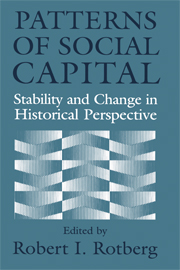Book contents
- Frontmatter
- Contents
- Introduction Social Capital and Political Culture in Africa, America, Australasia, and Europe
- Articles
- Civic Traditions in Premodern Italy
- The Sources of Civil Society in Italy
- Finding Social Capital: The French Revolution in Italy
- Social Capital in the Early Industrial Revolution
- The Diversity of Social Capital in English Communities, 1300–1640 (with a Glance at Modern Nigeria)
- Social and Cultural Capital in Colonial British America: A Case Study
- The Growth of Voluntary Associations in America, 1840–1940
- Civil Society as Democratic Practice: North American Cities during the Nineteenth Century
- Securing Political Returns to Social Capital: Women's Associations in the United States, 1880s–1920s
- Second-Generation Civic America: Education, Citizenship, and the Children of Immigrants
- Human Capital and Social Capital: The Rise of Secondary Schooling in America, 1910–1940
- From Local to National Political Cultures: Social Capital and Civic Organization in the Great Plains
The Sources of Civil Society in Italy
Published online by Cambridge University Press: 12 April 2010
- Frontmatter
- Contents
- Introduction Social Capital and Political Culture in Africa, America, Australasia, and Europe
- Articles
- Civic Traditions in Premodern Italy
- The Sources of Civil Society in Italy
- Finding Social Capital: The French Revolution in Italy
- Social Capital in the Early Industrial Revolution
- The Diversity of Social Capital in English Communities, 1300–1640 (with a Glance at Modern Nigeria)
- Social and Cultural Capital in Colonial British America: A Case Study
- The Growth of Voluntary Associations in America, 1840–1940
- Civil Society as Democratic Practice: North American Cities during the Nineteenth Century
- Securing Political Returns to Social Capital: Women's Associations in the United States, 1880s–1920s
- Second-Generation Civic America: Education, Citizenship, and the Children of Immigrants
- Human Capital and Social Capital: The Rise of Secondary Schooling in America, 1910–1940
- From Local to National Political Cultures: Social Capital and Civic Organization in the Great Plains
Summary
Putnam explains the successful democratic performance of regional governments in northern and central Italy since 1970, as opposed to the poor record of those in the South, as the product of an abiding tenacity of civic traditions. His analysis presupposes some fundamental historical questions:
“Why did the North and South get started on such divergent paths in the eleventh century?” The hierarchical Norman regime in the South is perhaps readily explained as the consequence of conquest by an unusually effective force of foreign mercenaries. More problematical and potentially more interesting are the origins of the communal republics. How did the inhabitants of north-central Italy first come to seek collaborative solutions to their Hobbesian dilemmas? The response to that question must await further research, not least because historians report that the answer seems lost in the mists of the Dark Ages. Our interpretation, however, highlights the unique importance of trying to pierce those mists.
This essay is an attempt to grope through the historical mists. Although the vast cultural chasm between us and the early Middle Ages makes it difficult to ask modernist questions of a decidedly archaic society, the so-called Dark Ages are not a cipher. A great deal can be discovered about the process of building civil societies in northern Italy. Even more important, the construction of civil society—as Putnam posits in his more recent work on social capital—was not so much an event as a process, the inner dynamics of which is clearly discernable in later periods, and the process was not always evolutionary. It was punctuated by dramatic moments of rapid political change.
- Type
- Chapter
- Information
- Patterns of Social CapitalStability and Change in Historical Perspective, pp. 41 - 68Publisher: Cambridge University PressPrint publication year: 2000
- 1
- Cited by



